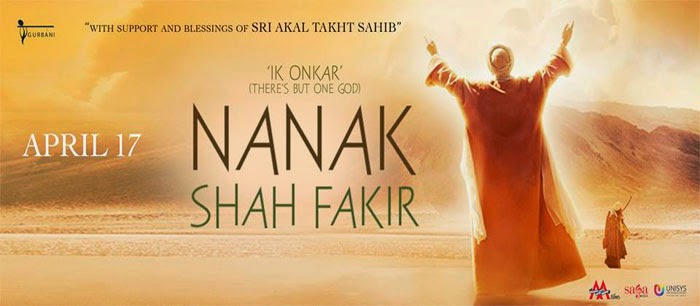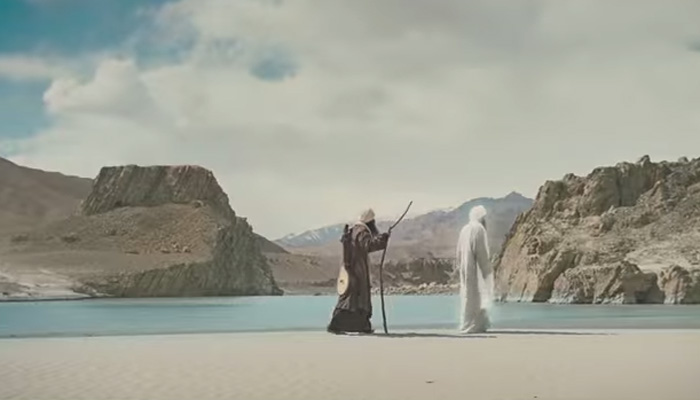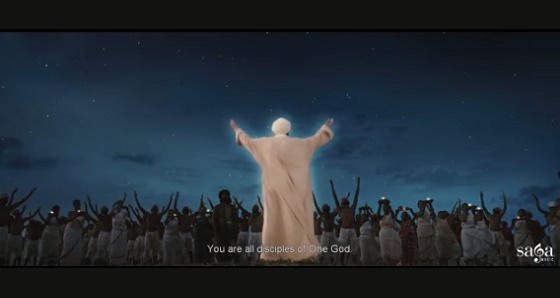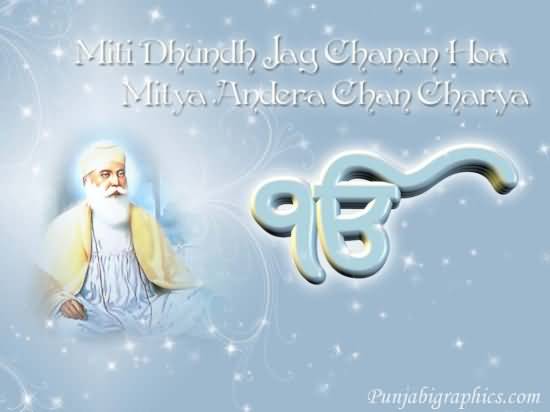India is a nation of debates, discussions and controversies. Our news channels generate enough in a week to last us a few lifetimes. If you listen to a news hour debate anchored by Arnab Goswami, for example, you would conclude that he, by himself, can account for a major part of global-warming.
Religious controversies, however, are not just an Indian phenomenon; all over the world, religious fervour and fanaticism can result into tempers running high, killings and violence in the name of God and Religion. The more anyone would want to liberate the world from ritualistic adherence to religion, the more anyone would desire a world free from fundamentalist hydra-heads, the more these mushroom everywhere. Historically, when Mankind drifted away from God and Godliness, many right-minded saints, gurus and incarnations of God Himself descended on earth to show the right path to the people. However, it appears that the Devil is perhaps as strong and more wily than God that people easily become the followers of the former and require reminders, again and again, to align themselves with God.
The above were my first reactions on seeing the premiere of Harinder Sikka’s Nanak Shah Fakir on 16th April 2015 in PVR, Juhu, Mumbai; and the ban on the movie in Punjab engineered by SGPC (Shiromani Gurudwara Prabhandak Committee) and a few other organisations ostensibly representing the best interests of Sikhs. Whilst discussing the ills of Kalyug over Satyug, Guru Nanak brought out that there is a great positive in Kakyug; which is that whilst in Satyug you required someone to pray for you, in Kalyug you are one to one with God. Nothing stands between you and God.

SGPC and other organisations haven’t seen the writing on the wall if they feel that they are intermediaries between us and God. They are as much out of sync as various Hindu organisations including militant ones who tell you what is acceptable to Hindus. They don’t keep you intact because of common culture and love but because of threat of violence in case you don’t listen to them. Incidentally, Guru Nanak and the movie shunned violence but the modern protectors of our religion think nothing of keeping their flock together through threat of violence.
And, as I write this, Harinder Sikka after receiving directions from Akal Takht Jathedar Giani Gurbachan Singh has decided to withdraw the movie for the time being even though he had earlier decided to go ahead with the release of the movie on 17th April with the above poster despite opposition from SGPC, DSGMC and Akal Takht mainly because portrayal of Sikh Gurus on the celluloid is not permitted. The movie has also been banned in UK bowing to the sentiments of the Sikh community.
I feel that Harinder Sikka and his team (Cast of Arif Zakaria (playing Mardana), Puneet Sikka (Harry’s daughter playing Guru Nanak’s elder sister Nanaki, Shraddha Kaul, Anurag Arora, Adil Hussain (playing landlord Rai Bular), Narendra Jha and Tom Alter; Music of Uttam Singh; Sound of Rosul Pookutty; and Cinematographer AK Bir) deserve to be congratulated for an outstanding movie on several counts.
Firstly, the idea behind the movie and its focus. I am convinced that Harry Sikka must have been chosen by God to take up such a project. Sri Guru Granth Sahib has a mention of such blessings showered by God on the chosen ones. The focus throughout the movie is on Guru Nanak and his teachings. There is no other side story; there is no attempt at direct teaching by the chronicler of the movie Mardana, for example or by the movie makers.

Secondly, I like the anecdotes that have been selected from the life of Guru Nanak. These have been selected with an eye on their current relevance. Once again, rather than forcefully and imposingly preaching, these have been as gently brought out as we imagine Guru Nanak to be. There are, for example:
Guru Nanak as a young boy refusing to wear the holy thread Janeyu that every Hindu male is required to wear by religion. This was Guru Nanak’s first opposition to ritualistic adherence to religion rather than binding oneself with God.
Nanak selecting a friend and consort who was always booed as Marjana (Cursed to die) and calling him Mardana. Mardana, the rebab player, a Muslim, accompanies Guru Nanak wherever he goes and gives musical accompaniment to his raagas.
Nanak being sent by his father Mehta Kalu (Full name Kalyan Chand Das Bedi) with 20 rupees “to do business”. Nanak buys food with the money and distributes amongst saints and poor. When questioned by his father, he responds that he has done Sachcha Sauda or “True Business”. It would be sometime before his father would understand. The movie indeed brings out how Rai Bular, the local landlord and Nanak’s elder sister Bebe Nanaki were the first to have recognise divine qualities in him even when he was a boy.
Nanak selling baajra at Sultanpur Mandi and whilst emptying the bowls in buyers’ bags, getting stuck at the count of terah (13), since terah also means ‘yours’ (in this case God’s). A complaint is made against him to Daulat Khan Lodhi, employer of Nanaki’s husband, through whom the job was given to Nanak. But, when the gunny-bags of grains are counted, there is no discrepancy!
Nanak’s wedding with Sulakhani and the mature understanding relationship that he had with her. At the end of the movie, Guru Nanak, back from an Udaasi (travel) to spread the word of God, is seen leaning on the shoulders of their two sons, Sri Chand and Lakshmi Chand and telling them the simple essence of his teachings:
Vand Chhako: Share with others in need.
Kirat karo: Earn or make a living honestly without fraud or exploitation.
Naam Japna: Meditate on God’s name.
Nanak was thirty years old, in the year 1499 when he went to meditate and bathe beside the river Kali Bein (Black River), accompanied by Mardana. Mardana later discovered Nanak’s clothes on the bank but Nanak was missing. A search was mounted for him including divers sent by Daulat Khan but there was no success. Everyone, except Babe Nanaki, assumed that he had drowned. Three days later, Nanak emerged from the river alive. He had achieved Enlightenment and the locals started calling him Guru. The very first words that he uttered after his Enlightenment were: “Na koi Hindu; na koi Mussalman” (There is no Hindu; there is no Muslim). This led to his prime teaching: Ek Omkar, there is One God.
Soon after his Enlightenment, Guru Nanak, accompanied by Mardana, went on his first Udasi (travel) to Bengal, Assam and Manipur (Between the year 1500 to 1524, Guru Nanak undertook five Udaasis, covering a distance of more than 28000 kms, in all four directions, as far as Tibet, Ceylon, Kashmir, Baghdad, Mecca and Medina.
The movie brings out some remarkable anecdotes during the Udaasis. The incident of his having accepted the invitation of a low-caste artisan, Bhai Lallo and rejected that of the rich landlord Malik Bhago was well covered. When Malik Bhago was enraged, Guru Nanak asked for the two meals: one from Lallo’s house and one from Bhago’s. He produced milk from the former and blood from the latter. Thus, in his simple but clear way of teaching, he brought home the difference between honest work and exploitation in order to obtain riches.
The second anecdote very well covered was at Hasan Abdal, near Rawalpindi. Guru Nanak, Bhai Mardana and a congregation gathered at the foot if the hill, atop which a Muslim priest Bawa Wali Qandhari had established his dera next to the only source of water there. Since Guru Nanak’s congregation was thirsty, Guru Nanak sent Bhai Mardana to request Wali Qandhari to release water for them. The latter angrily turned down the plea. Mardana was asked by Guru Nanak to go up again and request for water. Reluctantly he did and Wali Qandhari derisively asked Mardana to tell Guru Nanak to directly appeal to his God for water. Guru Nanak then lifted a stone over sand, dug with his hands and produced water. Meanwhile Wali Qandhari’s pond began to dry. Enraged he launched a huge rock down the hill in order to crush Guru Nanak and his followers. When the hurling rock came charging towards Guru Nanak, he merely touched it with his hand and the rock stopped. Wali Qandhari witnessed this and suddenly realised that Guru Nanak was a messenger of God and he then fell at Guru’s feet. We all know that the spot of this miracle is marked by Gurudwara Panja Sahib.
My favourite incident of Guru Nanak’s Udaasis, accompanied by my favourite hymn, has been depicted so well in the movie that it left me stunned. The incident at Jagannath Puri, just before the annual rath yatra has Guru Nanak being invited for the Aarti at the temple.
The Guru visited the temple not to offer Aarti to Lord Krishna but to teach the people that the worship of God is superior to the worship of the deity. It was the evening time and the priests brought a salver full of many lighted lamps, flowers, incense and pearls and then all stood to offer the salver to their enshrined idol-god. The ceremony was called ‘Aarti’, a song of dedication. The high-priest invited the Guru to join in the god’s worship. The Guru did not join their service which enraged the priests. On being asked the reason the Guru explained that a wonderful serenade was being sung by nature before the invisible altar of God. The sun and the moon were the lamps, placed in the salver of the firmament and the fragrance wafted from the Malayan mountains was serving as incense. The Guru, therefore, instead of accepting the invitation of the high-priest to adore the idol, raised his eyes to the heaven and uttered the following Shabad as Aarti (Punjabi: Kaisi aarti hoy…)
“The sun and moon, O Lord, are thy lamps; the firmament
Thy salver; the orbs of the stars, the pearls enchased in it.
The perfume of the sandal is Thine incense; the wind is
Thy fan; all the forests are Thy flowers, O Lord of light.
What worship is this, O Waheguru (God)?
This hymn and the scene in the movie at the sea-shore are a powerful message against ritualistic observance of religion, meaningless and fruitless practices and institutions. Instead, one should directly be with God as a supplicant.

If I have to sum up the movie in one word, I would call it outstanding. And yet, the movie has controversies about it. The media talks about “objectionable scenes in the movie” but no one has specifically brought out as to what is objectionable. So, we are left to wonder whether the so-called guardians of religion have their egos hurt that such a fine movie has been made not because of them, but, in spite of them. Guru Nanak cautioned us all against giving in to haume (I am); five centuries later, is it that the guardians of religion themselves are ruled by haume?
Secondly, doesn’t Guru Nanak belong to all of us surpassing the boundaries of religion? In which case, does our personal observance of his teachings have to be coloured by some intermediaries?
Whilst on this issue, and it is a very touchy issue, the very first utterance of Guru Nanak, after Enlightenment is that there is no Hindu and there is no Mussalman. Five centuries later, we are propagating that even Hindus and Sikhs are different! If that is indeed the case then who exactly is going to reform the religious practices of Hindus and Muslims that Guru Nanak had set out to do? Why is it that idol worshipping is as prevalent today as it was many centuries back? Why are even elections in our so-called democratic society fought on basis of castes that Guru Nanak sought to eradicate? I have visited many gurdwaras and the ritualistic practice of sukh-aasan of the Sri Guru Granth Sahib (Resting of SGGS for the night) would compete with the ritualistic aarti of Jagannath Puri that Guru Nanak was opposed to. If Guru Nanak was to be born again, he would surely tell that when his tenth successor Gobind Singh ordained, “Guru Granth ko maaniyo, pargat Guran ki deh” (“Consider the Granth as your Guru now onwards; wherever the Granth is present, the Guru is bodily present”), he meant the observance of the teachings contained in SGGS and not ritualistically following it as the flesh and body of the Gurus. Guru Nanak wrote about one fifth of the Shlokas in the SGGS and many of these bring out how to be a true Muslim or Hindu sans the rituals. Even in the movie, when Daulat Khan asks him to do the Namaaz with them, he joins. But, when he is told that although he sat with them, he hardly said the Namaaz; Guru Nanak brought out that even they didn’t do so since whilst their lips moved, their minds were elsewhere! Why do we forget all his teachings and observe religion in rituals only?
The other day someone asked me as to why the Sikhs (the word Sikh, to me, has much greater meaning than the narrow confines of religion that were, in any case, opposed by Guru Nanak himself. The word means “the taught” or learned or one who has gained consciousness through his true intellectual growth) have prospered and survived many centuries after the Gurus? My instant response was that the Sikh gurus lived with their people through adversity and kept the flock together through personal sacrifices and examples. A Sikh, therefore, finds his way out of any adversity, trials and tribulations. His faith in oneness of God makes him so brave that he can battle against totally hopeless situations and emerge a winner (the Battle of Saragarhi, for example, on 12 Sep 1897, had 21 Sikhs of 4th Battalion of Sikh Regiment under the British fighting against 10000 Afghans; read ‘Battle of Saragarhi‘ on Wikipedia recorded by the UN as the bravest battle in the world ). Who were the leaders after our Gurus who were fired by the same spirit of sacrifice and selflessness? The factionalism both in our religion and politics, in the current world, is to be seen to be believed. Most of it is based on haume.
One of the arguments against the movie, surprisingly, is that “sentiments of the Sikhs have been hurt”. I have brought out in a series of articles (For example, read: ‘Who Are The “People” Whose “Sentiments Need To Be Respected”‘ and ‘Whose God Is It Anyway?’) that people or mobs do not always have the best sense. If they did in history, for example, we didn’t require the likes of Guru Nanak to bring them to the right path. Lets not follow the edict blindly that Sikh Gurus cannot be depicted on-screen. First of all, as the makers have clarified no human being is represented as the Guru; he being depicted only through a computer graphic. Secondly, if hundreds and thousands of pictures and write-ups are available on the net, in the books, movies, and on the television, why only in the movie that these are not permitted? And, most importantly, the movie makers have taken no license to distort history; the events have been, to the best of my knowledge, brought out as historically recorded.
Guru Nanak was one voice against the social ills of his times. He was eminently successful but now we are back to square one. Now is the time when a movie such as Nanak Shah Fakir should be most welcome and seen by all classes and conditions of men and women everywhere. The region of Punjab that Guru Nanak was born in and lived in has the menace of drug-addiction amongst the youth. His teachings would be most relevant to such misguided elements. Religious fundamentalism has shown its ugly ahead in the world again and there is violence and killings in various parts of the world; just as it was Babar’s forces that unleashed unheard of violence in India that was depicted at the end of the movie. We need the teachings of Guru Nanak all over again. Greater part of India is once again in the grip of idol worshipping, corruption, intolerance and the like. We need a messenger of God like Guru Nanak to do away with the dhund (mist) of ignorance and bless the people with chaanan (Light).
So, rather than banning, opposing or protesting against Harry Sikka’s movie, we should ensure that as many people as possible should see it and profit from Guru Nanak’s messages of one God and oneness with God, no haume, no religious and caste divides, Vand Chhako, Kirat Karo and Naam Japna. As the makers of the movie have proclaimed, all proceeds from the sale of tickets would be used to further the teachings of Guru Nanak.


Dear Sunbyanyname,
Great work done by you to bring out in simple words what the movie attempts i.e. bring out the teachings of Guru Nanak Dev ji. Guru Nanak Dev ji did not and does not belong to any one religion. He belongs to the entire humanity. His teachings/preachings are applicable to the entire world. Limiting Guru Nanak Devji to any one sect or religion is sacrilege so to say.
I would go to the extent that all the Gods/Godesses of Hindu religion, Jesus Christ, Zoraster, Prophet Mohammad (SAW), Gautam Buddha, Bhagwan Mahaveer, Guru Nanak Dev ji, Guru Gobind Singh ji, all the eight gurus between Guru Nanak Dev ji and Guru Gobind Singh ji, Sant Kabir, Sant Gyaneshwar, Sai Baba, and all the Perfect Masters who have walked on earth were sent by God to preach the oneness of his holy existence to the entire humanity and not just to a group of people. The group of followers were their initial disciples but their message has been spread to the entire humanity. Therefore they belong to the entire humanity.
The message spread by all the Perfect Masters talks of One God who has created the universe, who rears his creation and who destroys the creation when it has done what it was supposed to. They spread belief and faith in God, peace, love and universal brotherhood. This above all is beyond any controversy. Rituals, beliefs and self centered intrests of the so called “Dharam ke Thekedars” create controversy not the teachings/preachings of the Perfect Masters.
Thank you Vipan for your well thought of comments. It is a pity that we bind the greatness of teachings of such luminaries in the narrow confines of religion as we understand it and choose to practise. By the way, if you go into the Vedas and the teachings, there is no difference between them and Guru Nanak’s. It is only after the 4th to 6th century AD that the Hindu religion saw the advent of idol worship having been brought in mainly to whet the appetites of the “Dharam ke thekedaars”. Indeed, in the travelogues of Chinese pilgrims Fa Hien and Hiuen Tsang, they covered that except for Buddhist Bihar, they did not come across a single place in India wherein idol worshipping was prevalent!